Zoom commissioned a Morning Consult survey¹ in June and July 2022 to learn more about senior leaders’ sentiments on the future of work. The results indicate that even top leadership prefer hybrid work for themselves, and see many benefits associated with flexible working models.
Survey: Executives Want Flexible Work, Too

- 01 Yes, the future of work really is hybrid - Jumplink to Yes, the future of work really is hybrid
- 02 Why leaders prefer flexible work - Jumplink to Why leaders prefer flexible work
- 03 What hybrid looks like - Jumplink to What hybrid looks like
- 04 The widespread impact of flexibility - Jumplink to The widespread impact of flexibility
- 05 Building connections through strategic activities - Jumplink to Building connections through strategic activities
- 06 Simplify hybrid work with technology - Jumplink to Simplify hybrid work with technology
- 07 Methodology - Jumplink to Methodology
Introduction
According to a recent poll, employees value choice — just over two-thirds (69%) of workers say it’s important for them to be able to choose whether they work in-person, remotely, or hybrid.
People want to tailor their working style and schedule to their needs — and they’re willing to make a change if their organization doesn’t accommodate that preference. Flexibility in where, when, and how people work informs talent recruitment and retainment, with almost half (45%) of respondents in a Momentive poll saying it’s likely they would look for a new job if they are not able to work in their ideal location.
This has tasked leaders with identifying and establishing new policies to address employee needs — with many establishing a mix of in-person and remote work as a new norm.
It’s clear employees value workplace flexibility, but what about their company’s leaders — what do they prefer? How do the people enacting these policies really feel about them? Do they believe it positively impacts employees? How do they think hybrid work can benefit their business?
Those are the questions Zoom decided to explore, partnering with Fortune to commission a Morning Consult survey¹ that examines leaders’ sentiments on hybrid work and its overall impact on employee happiness, company culture, and business objectives. Respondents needed to work at an organization that operated either hybrid or fully remote for the past six months. A few top findings that emerged from this survey:
- Leaders like flexible work schedules, too — more than 90% said they preferred a hybrid or remote working environment versus in-person only.
- When asked about how they prefer where their employees work, the leaders surveyed lean a little more toward remote — averaging a 60% time remote, 40% time in the office split.
- They believe the impact of hybrid work and working remotely has been more positive than negative, especially in terms of employee experience. Seventy-one percent believe hybrid and remote work has had a positive impact on employee happiness.
- Many believe hybrid and remote work have either had no impact or a positive impact on the quality of connections, with 31% feeling like working remotely has increased their quality of connection with direct reports, and 54% feeling the quality has remained the same.
- The vast majority (84%) agree that strong workplace relationships can be built in a fully in-person workplace, and a similar share (85%) says the same about a hybrid workspace.
Read on for a more in-depth look at the survey findings.
Leaders see the writing on the wall — they know hybrid work is here to stay. More than 4 in 5 (86%) agree with the statement “the future of work is hybrid,” while only 4% disagree. That belief is present on a personal level as well, as nearly 56% say they personally prefer a hybrid working environment, while 35% prefer fully remote, and just 9% prefer fully in-person.
They have a similar vision for employees as well, as half (50%) prefer a hybrid environment for their employees, 24% prefer a fully remote environment, and 18% would let their employees decide for themselves. Just 8% say they prefer a fully in-person workplace environment for their employees.
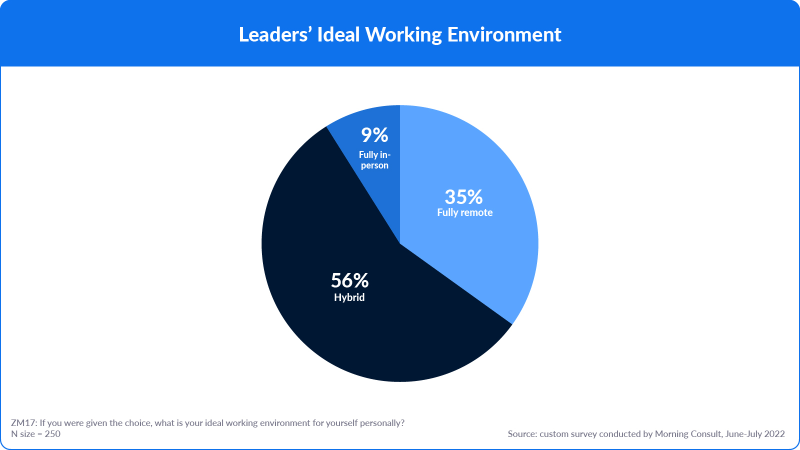
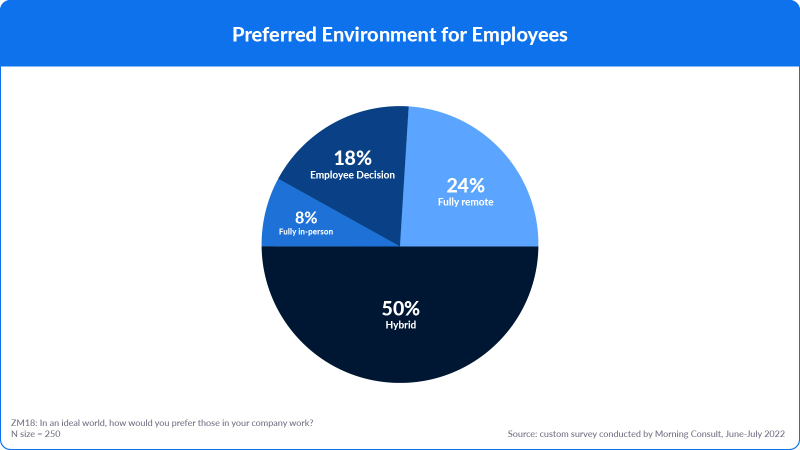
A lot of factors are behind respondents’ preference for hybrid work, chief among them: meaningful and quality work for employees.
When asked to rank what factors are most important when deciding on the best working arrangements for their company (on a scale of 1-6, with one being the most important), the leaders surveyed ranked enabling productivity as the most important factor (2.86), followed by increasing team collaboration (3.44) and maintaining a strong company culture (3.56).
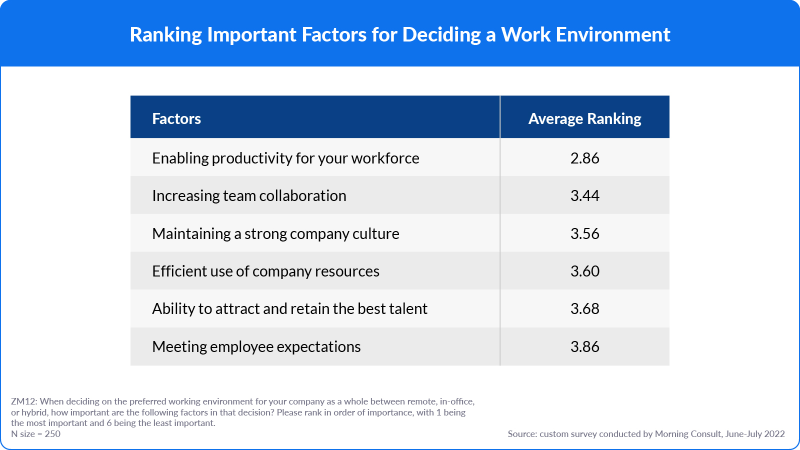
One leader validated this focus on productivity in their own words:
“It gives the best outcome of both worlds. Better productivity for the employer and better work-life balance for the employees.” – Leader who prefers a hybrid environment for employees
There’s no one-size-fits-all approach to a hybrid work model. Leaders everywhere are tailoring the split between remote and in-office environments per their companies’ unique needs. But of the leaders surveyed, the breakdown leaned more toward working remotely, with respondents believing 60% of the time can be spent remote and 40% of the time in-person.
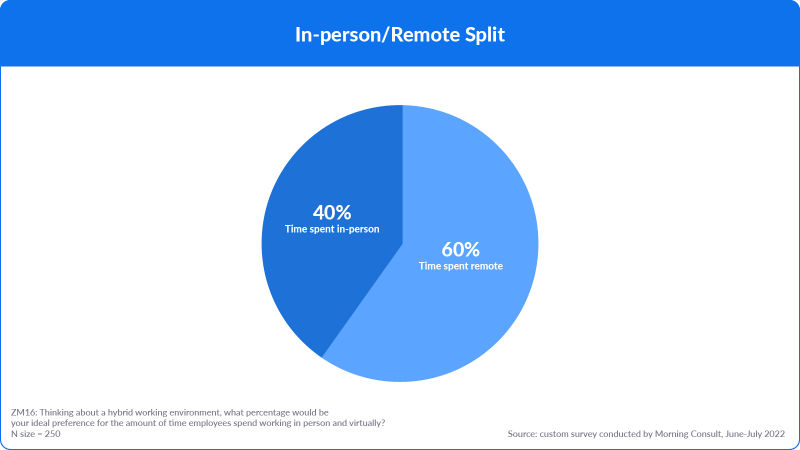
“Because they feel in control of their situation and can balance their lives, they will be happier and more productive at work,” one of the surveyed leaders said.
Workspace flexibility has a fairly positive ripple effect, according to the leaders surveyed. Morning Consult’s findings revealed that the impact of hybrid and remote workplaces has been perceived by leaders as much more positive than negative, particularly when it comes to employee happiness and the quality of connections.
Seventy-one percent believe hybrid and remote work has had a positive impact on employee happiness, 58% on employee retention, 57% company-wide communication, and 52% on team connectedness.
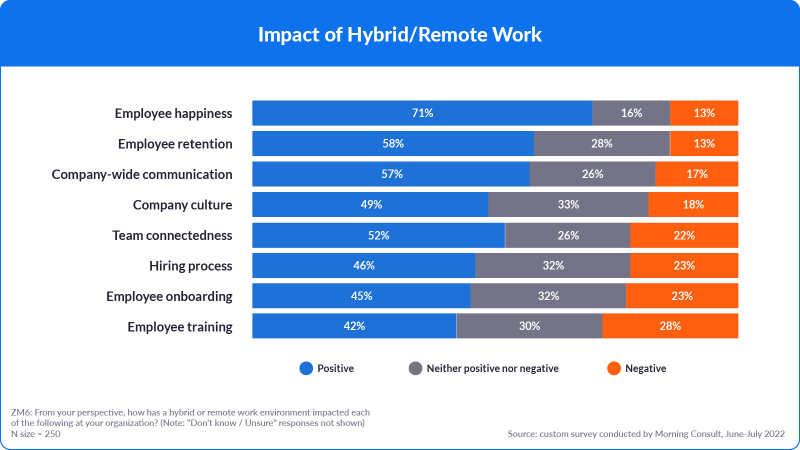
In fact, a common survey theme was that remote and hybrid work has mostly strengthened or not impacted co-worker connections and the quality of those connections. Thirty-four percent feel more connected with direct reports due to remote work, whereas 51% feel no impact either way.
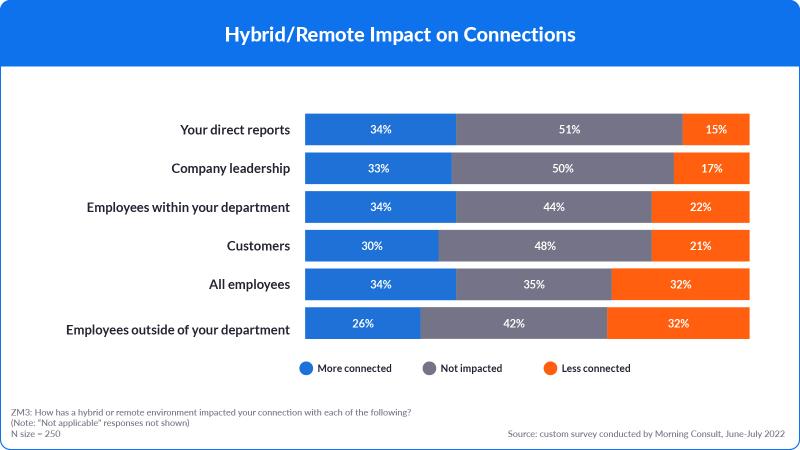
A similar story emerged for the quality of connections as well. Thirty-one percent feel like remote work has increased the quality of the connections they have with direct reports and 54% feel the quality has remained the same, whereas 31% feel that remote work has increased the quality of the connections with company leadership and 55% feel the quality has remained the same.

It’s little surprise that these senior leaders identified more benefits in remote and hybrid workplaces than in-person environments. When provided with a list of potential benefits to each work environment, 35% of leaders surveyed selected “None of these” for in-person work, compared with 13% for hybrid work, and 17% for fully remote work. The top benefits of hybrid work include increased flexibility for employees (57%), improved retention rates (57%), improved work/life balance (56%), and increased productivity (53%).

Similarly, more challenges were identified with in-person work than with hybrid and remote work. When provided with a list of potential challenges to each work environment, 18% of leaders surveyed selected “None of these” for in-person work, compared with 41% for hybrid work, and 27% for remote work. The top challenges identified for in-person work included increased health risks (59%), negative environmental impact (55%), and increased company expenses (52%).
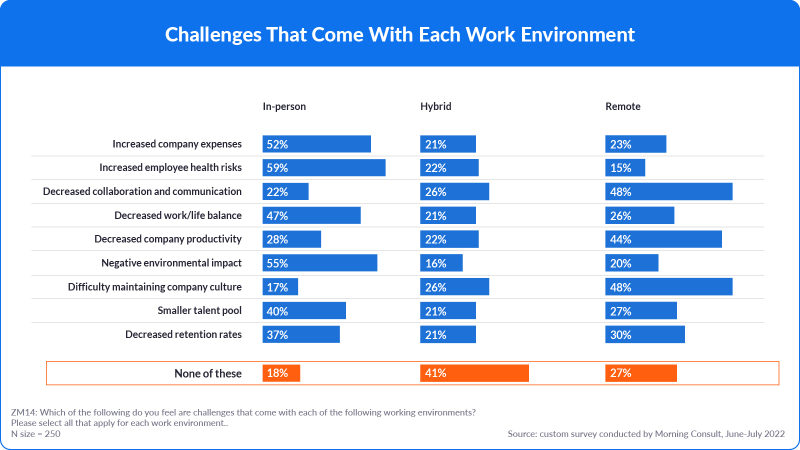
By definition, hybrid means some elements of work take place both remotely and in person. Leaders have preferences around what those elements are.
According to the Morning Consult survey, more leaders believe that events, such as company-wide town halls (56%) and large group meetings (54%), are better suited for a virtual format than in-person. However, they prefer an in-person format over a virtual format for team social events (57%), job candidate interviews (56%), and customer meetings (50%).
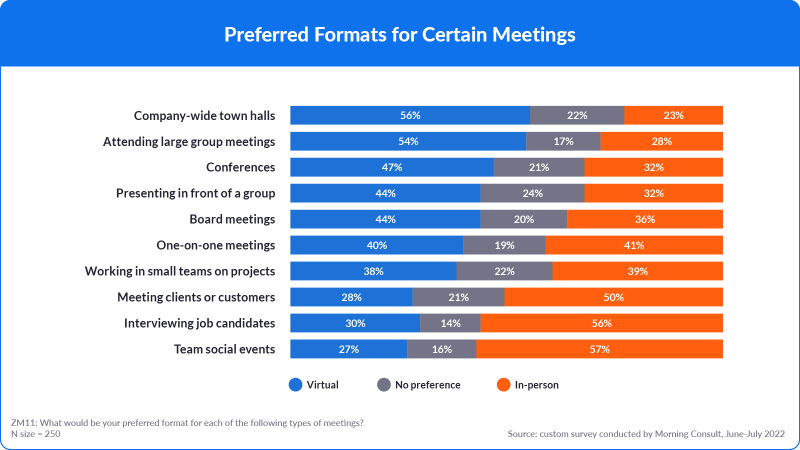
Leaders’ preference for virtual company-wide meetings may also help strengthen company culture. When asked what practices they’ve found to be helpful in strengthening connections among team members, they called out company-wide meetings and town halls (79%), employee trainings (75%), and team-building exercises (77%) to be somewhat or very helpful.

Leaders want to create an environment that enables productivity, increases team collaboration, and helps contribute to a strong company culture. And most of the leaders here believe they can get all of that in a hybrid work environment, where employees are happiest. So, once they’ve established the mix of remote and in-office work that feels right, leaders need to next identify technology partners that can help them carry out their hybrid vision.
That starts with adopting technology that fosters organizational resilience — solutions optimized for connection-building. Employees want to take town halls from home? Check. Want to create an opportunity for team bonding, regardless of where the team is located? Done. The right technology strategy lets you have your cake and eat it, too.
At Zoom, we offer an experience-first communications platform optimized for this new flexible work future:
- Zoom Workplace, an all-in-one communication and collaboration offering designed to connect your teams no matter where they are
- Zoom Rooms Smart Gallery, designed to create an inclusive experience that promotes equality for both in-person and remote workers through AI technology
- Real-time captioning to truly bring people together, enabling employees to work globally while feeling heard, connected, included, and equal
Happy, connected teams can do their best work wherever they are — rooting work in a sense of people and purpose, rather than a place. The results will pay massive dividends in the long run, fostering a strong company culture, happier customers, and a resilient organization.
This survey was conducted among 250 U.S. senior leaders, defined as those with a title of Vice President or higher, including Owner, Partner, President, Founder, and Co-Founder. Respondents needed to work at an organization that operated either hybrid or fully remote for the past six months, and use collaboration software such as video conferencing, chat and messaging, or webinars.
This survey was conducted online from June 16 to June 28, 2022, and July 14 to July 18, 2022. The margin of error for the full sample is plus or minus 6 percentage points.
Get connected today
Learn how you can use our unified communications platform to streamline team collaboration, strengthen connections, and improve the way you work.






